Health care seeking behaviuor among the elderly in Hue City
Objectives: the study is to investigate health care seeking behaviour and to identify factors associated
those behaviour among elderly living in Hue city, Vietnam.
Methods: 400 old persons who suffered from health problem in the past one month were interviewed
directly at their house by a structured questionnaire to survey health care seeking behaviour. Multivariate
logistic regression models were applied to identify factors affecting health care seeking behaviour among
participants.
Results: 72.5% of respondents sought treatment services for their acute illness in the past one month
and 68% of them used prevention services in the past one year before the interview. In general, source
of income, educational level and severe level of disease influenced health care seeking behaviour among
participants.
Conclusions: The findings revealed limitation of the elderly to access health care services, especially
health preventive services in Hue city. The identified associated factors can help formulate effective public
health programs to improve health status among the elderly in Hue city as well as in the country in general.
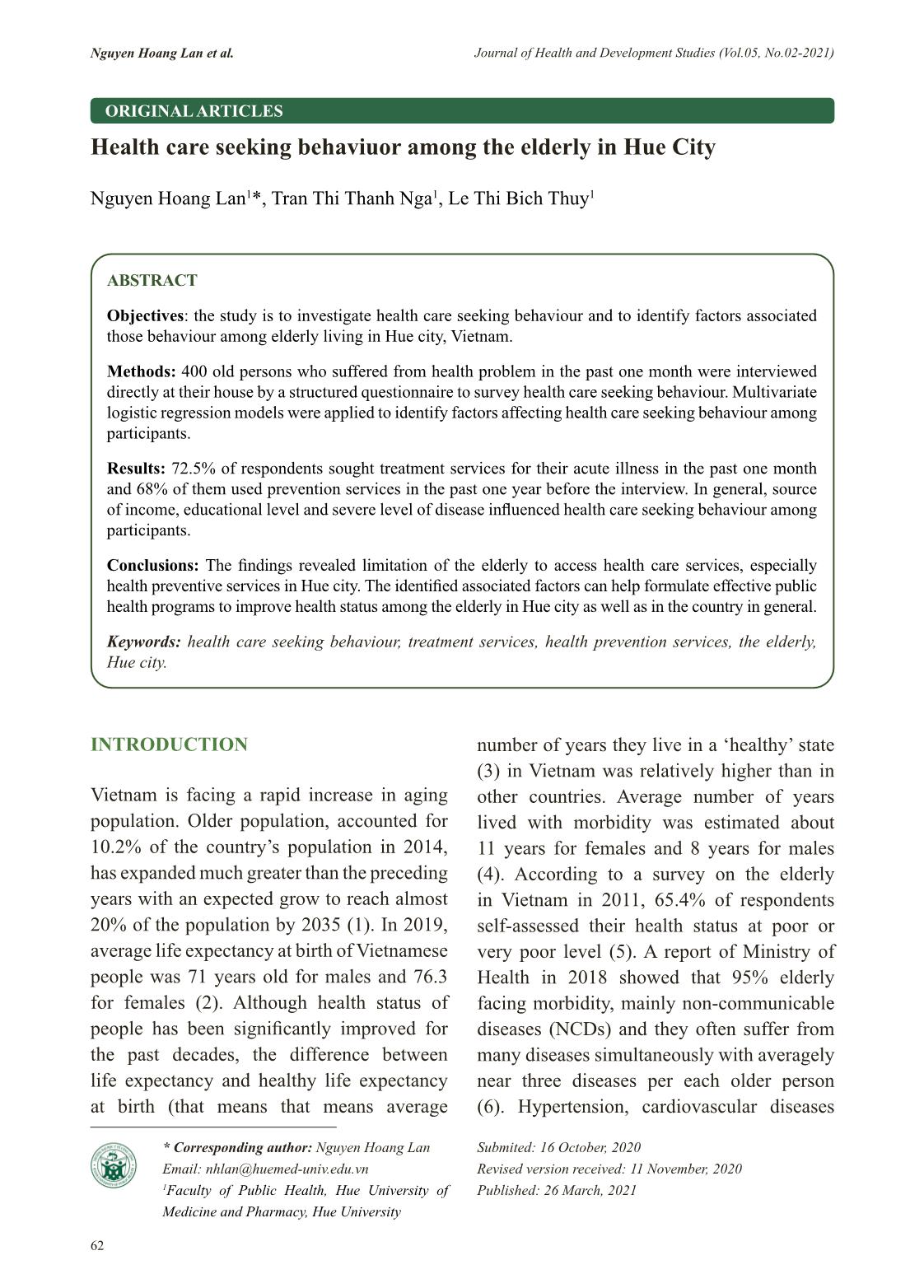
Trang 1
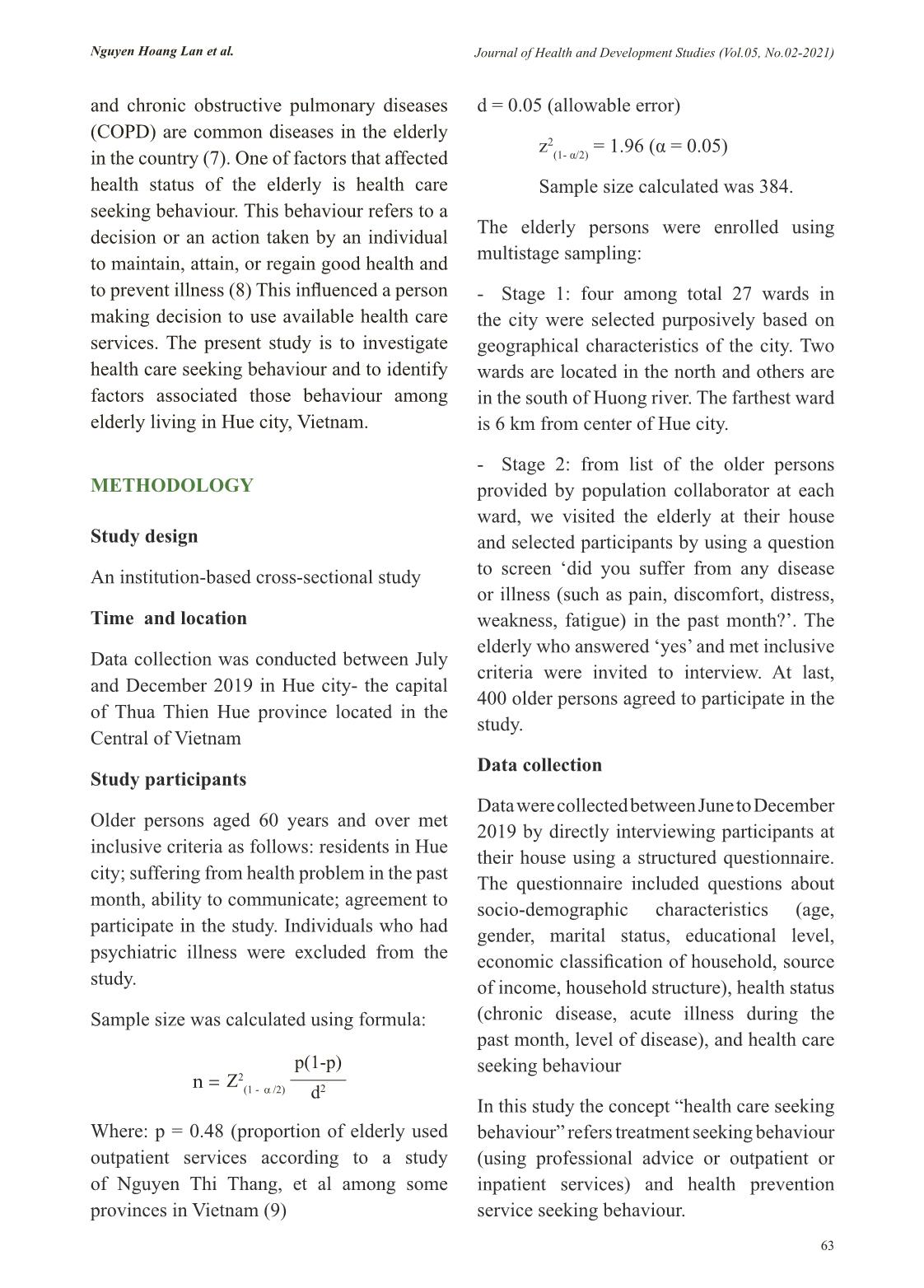
Trang 2
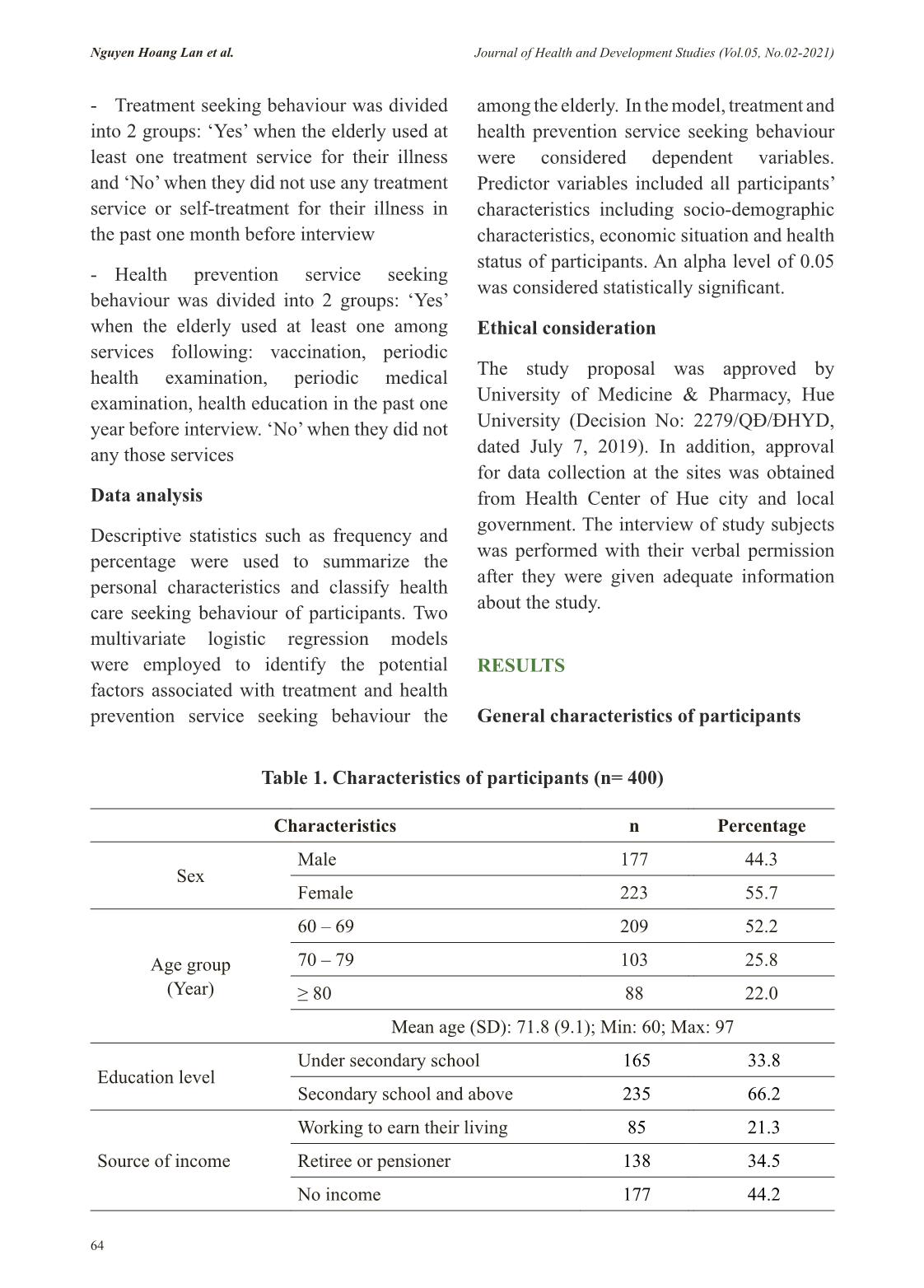
Trang 3
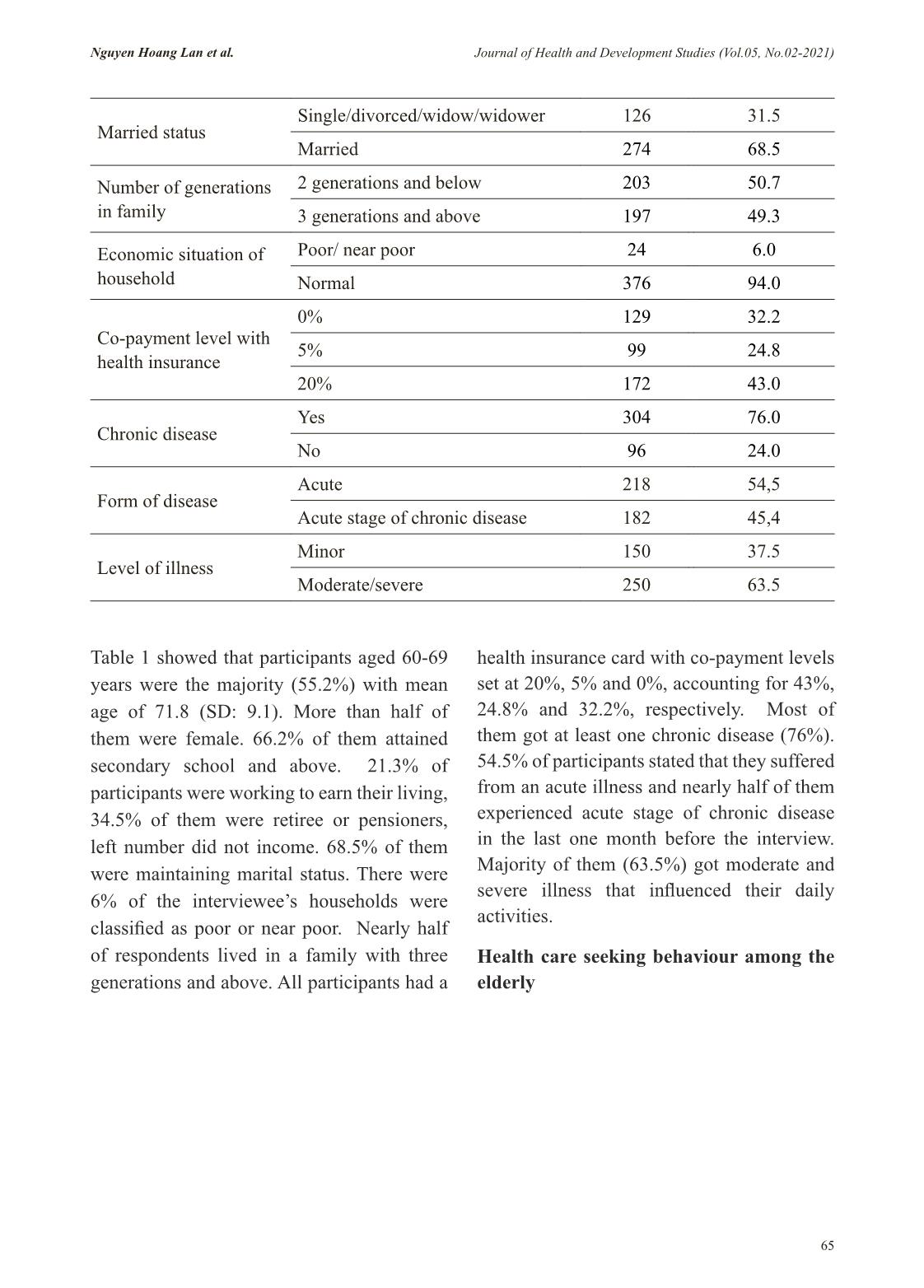
Trang 4
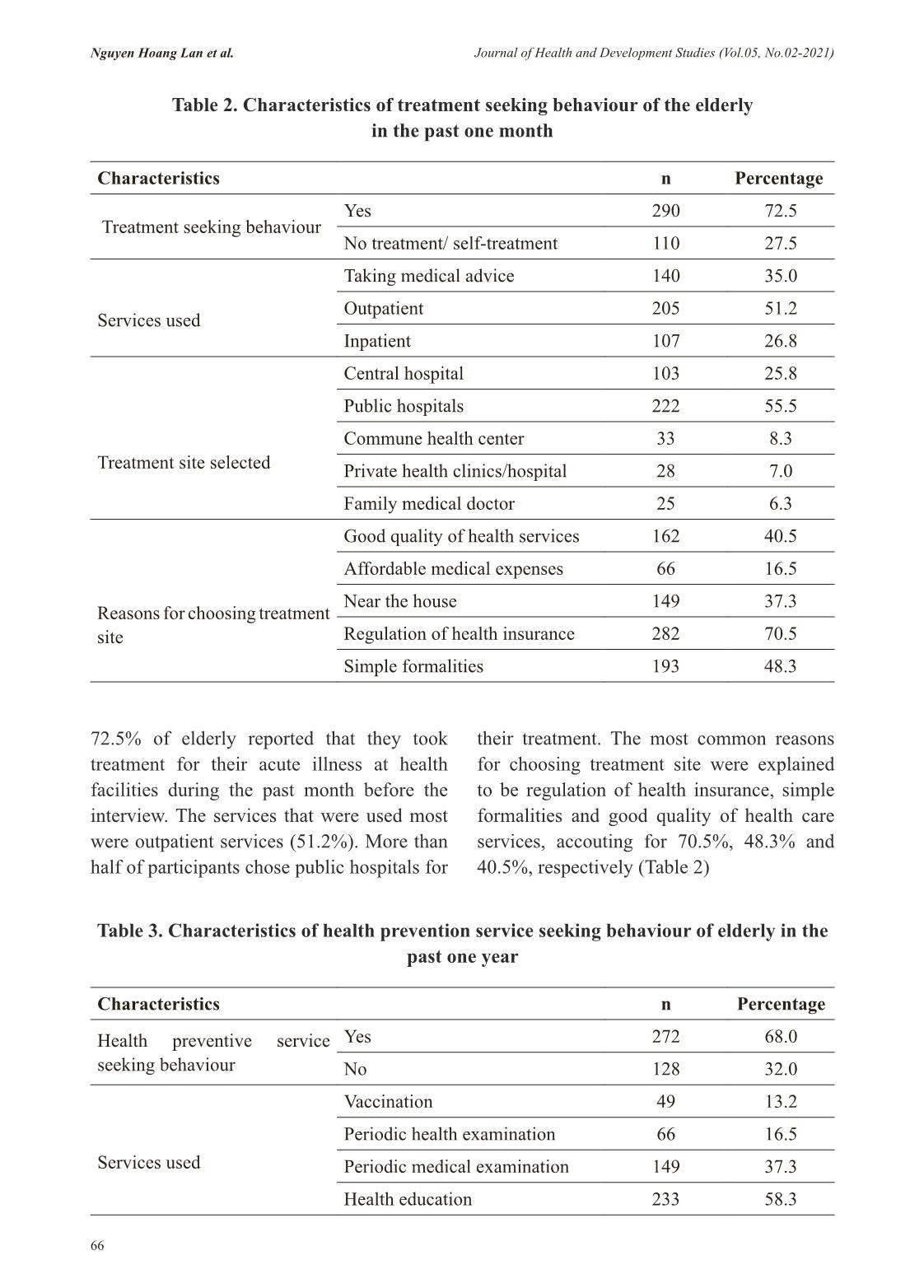
Trang 5
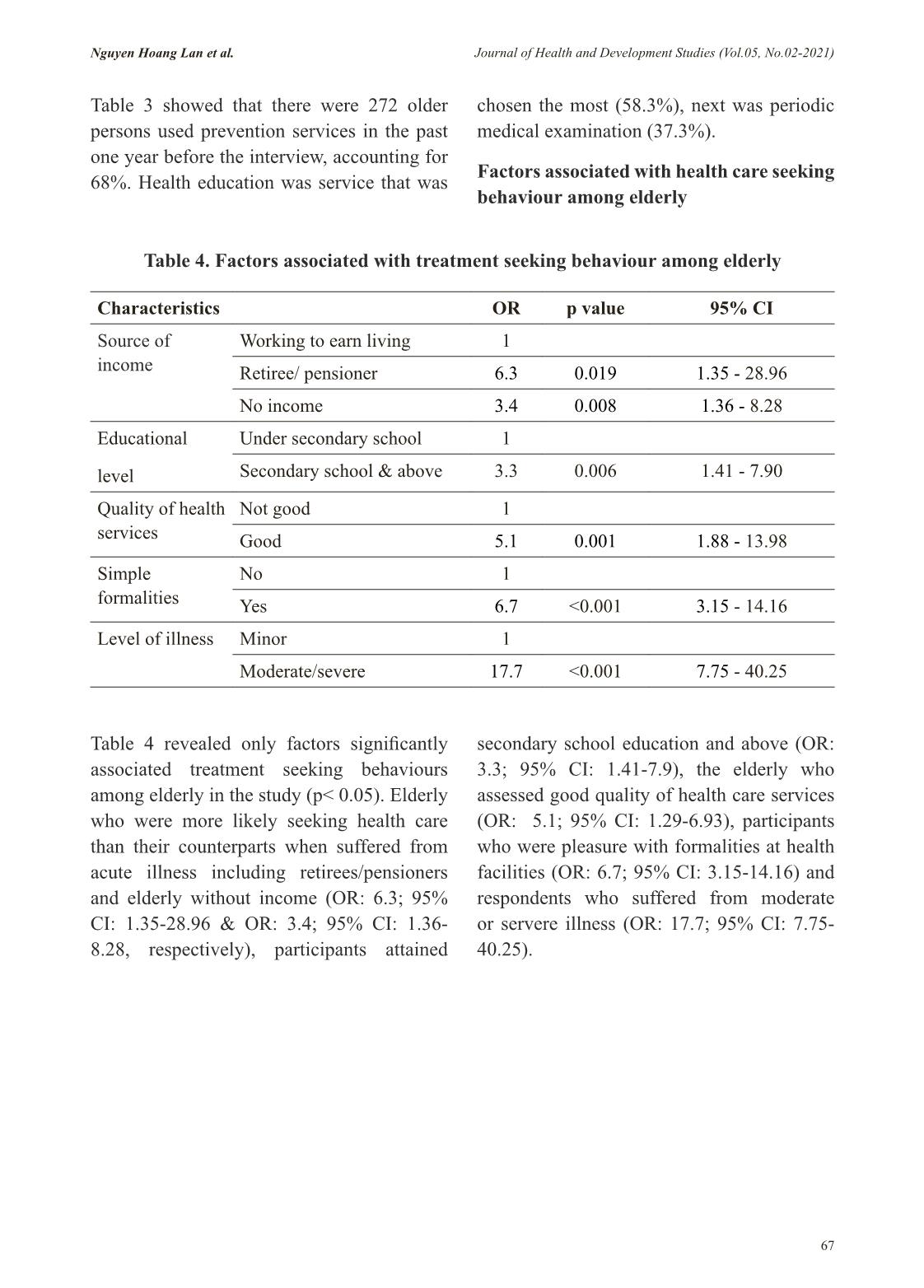
Trang 6
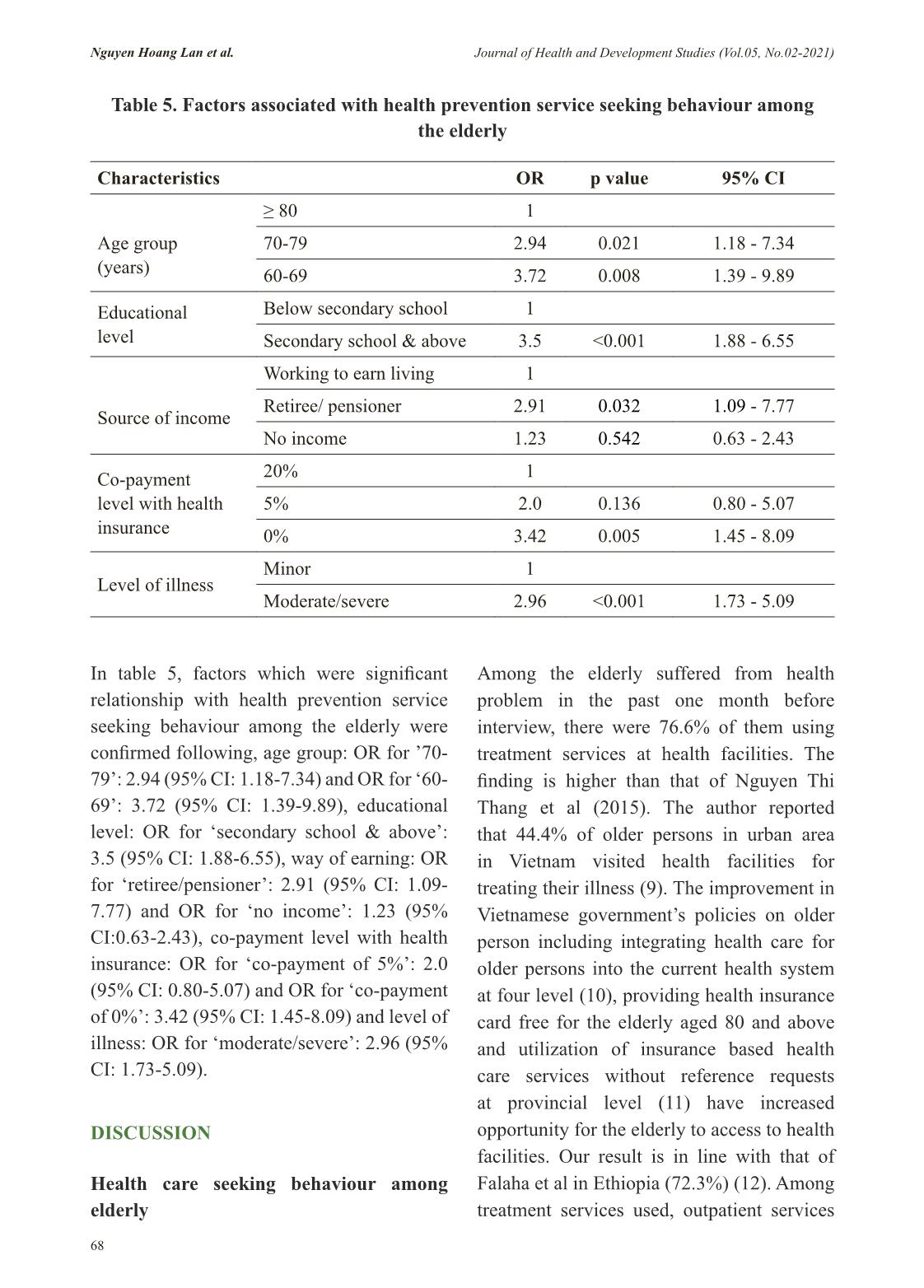
Trang 7

Trang 8
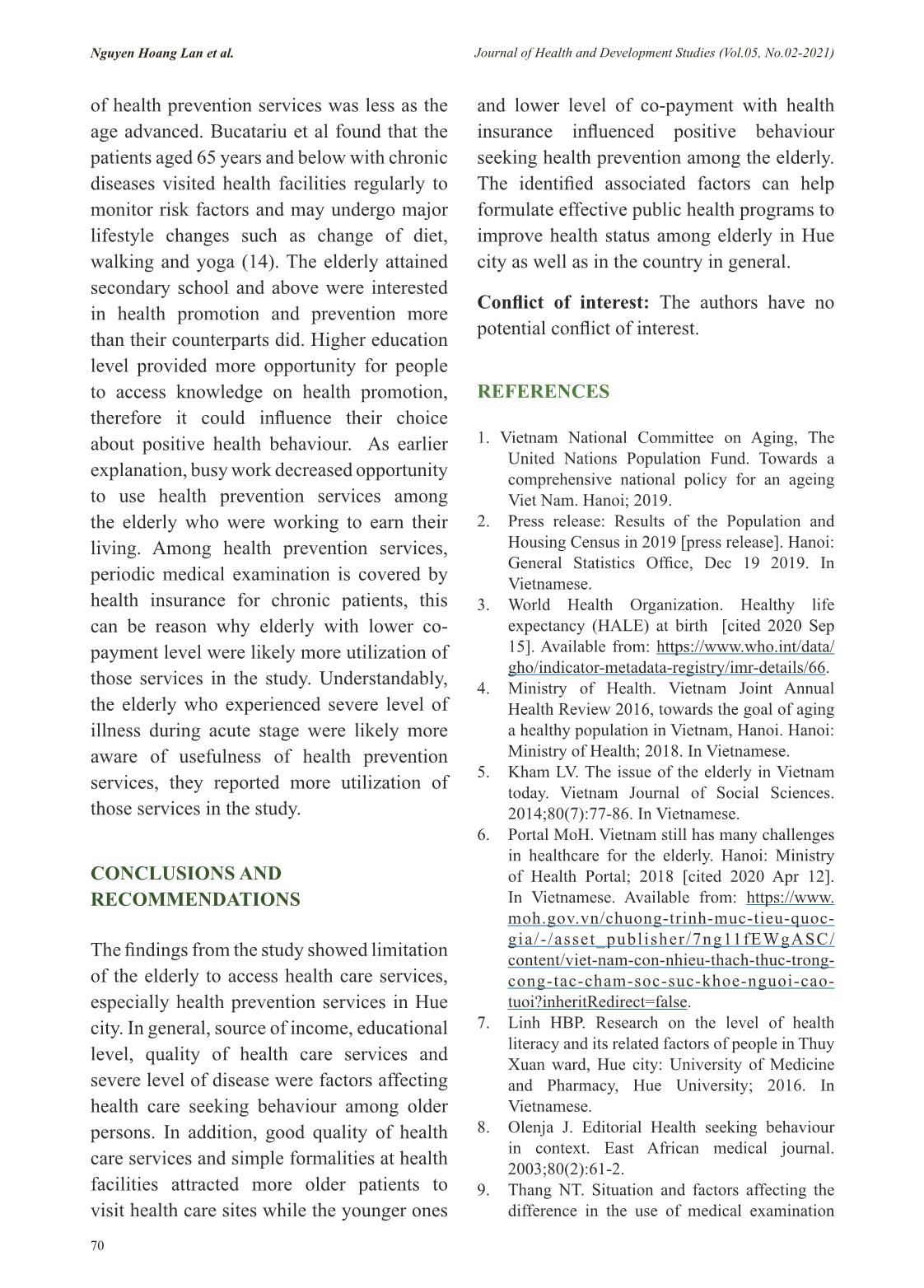
Trang 9
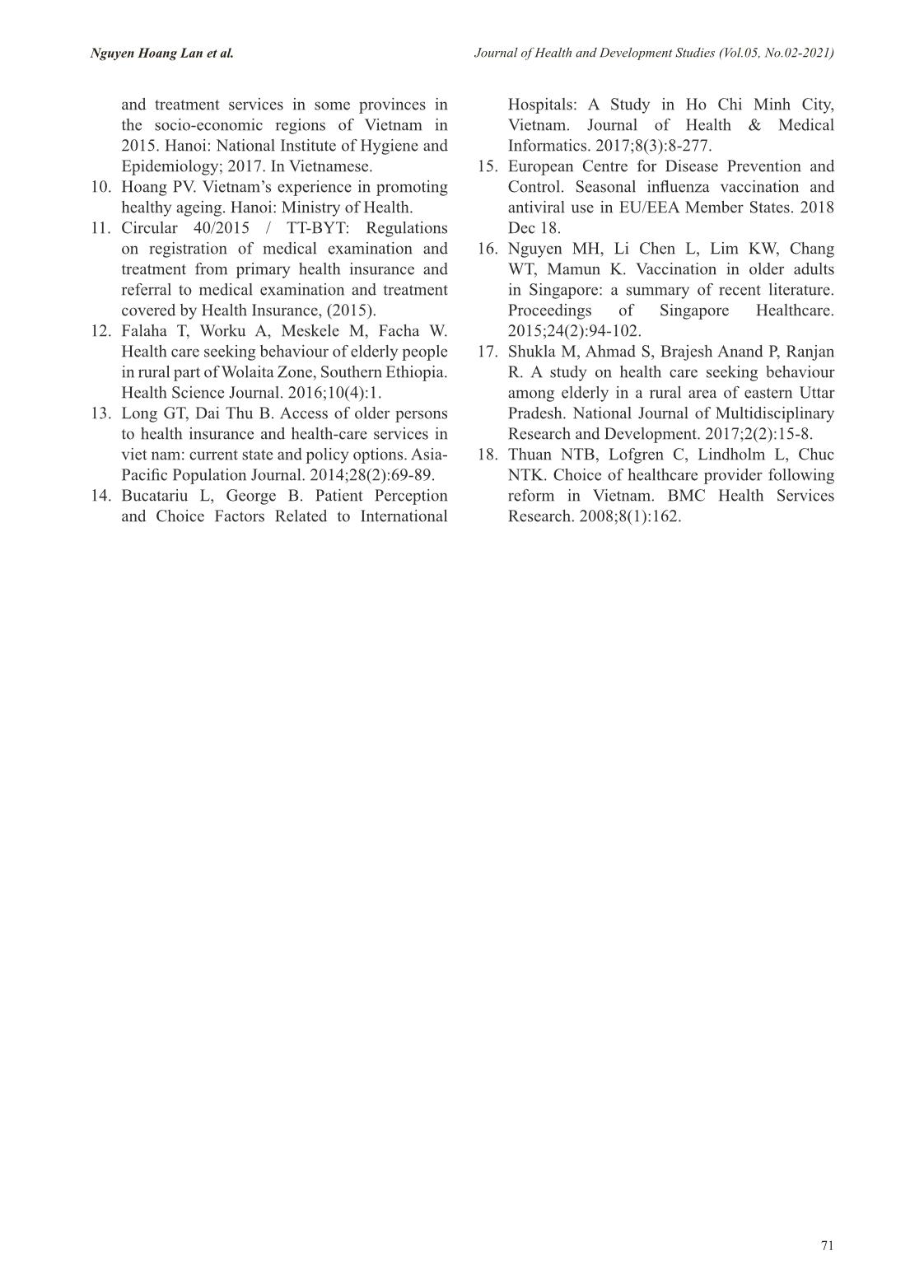
Trang 10
Tóm tắt nội dung tài liệu: Health care seeking behaviuor among the elderly in Hue City
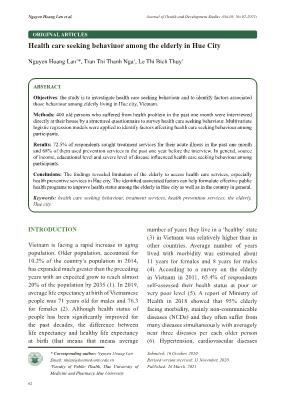
62 Journal of Health and Development Studies (Vol.05, No.02-2021)Nguyen Hoang Lan et al. INTRODUCTION Vietnam is facing a rapid increase in aging population. Older population, accounted for 10.2% of the country’s population in 2014, has expanded much greater than the preceding years with an expected grow to reach almost 20% of the population by 2035 (1). In 2019, average life expectancy at birth of Vietnamese people was 71 years old for males and 76.3 for females (2). Although health status of people has been significantly improved for the past decades, the difference between life expectancy and healthy life expectancy at birth (that means that means average number of years they live in a ‘healthy’ state (3) in Vietnam was relatively higher than in other countries. Average number of years lived with morbidity was estimated about 11 years for females and 8 years for males (4). According to a survey on the elderly in Vietnam in 2011, 65.4% of respondents self-assessed their health status at poor or very poor level (5). A report of Ministry of Health in 2018 showed that 95% elderly facing morbidity, mainly non-communicable diseases (NCDs) and they often suffer from many diseases simultaneously with averagely near three diseases per each older person (6). Hypertension, cardiovascular diseases Health care seeking behaviuor among the elderly in Hue City Nguyen Hoang Lan1*, Tran Thi Thanh Nga1, Le Thi Bich Thuy1 ORIGINAL ARTICLES * Corresponding author: Nguyen Hoang Lan Email: nhlan@huemed-univ.edu.vn 1Faculty of Public Health, Hue University of Medicine and Pharmacy, Hue University ABSTRACT Objectives: the study is to investigate health care seeking behaviour and to identify factors associated those behaviour among elderly living in Hue city, Vietnam. Methods: 400 old persons who suffered from health problem in the past one month were interviewed directly at their house by a structured questionnaire to survey health care seeking behaviour. Multivariate logistic regression models were applied to identify factors affecting health care seeking behaviour among participants. Results: 72.5% of respondents sought treatment services for their acute illness in the past one month and 68% of them used prevention services in the past one year before the interview. In general, source of income, educational level and severe level of disease influenced health care seeking behaviour among participants. Conclusions: The findings revealed limitation of the elderly to access health care services, especially health preventive services in Hue city. The identified associated factors can help formulate effective public health programs to improve health status among the elderly in Hue city as well as in the country in general. Keywords: health care seeking behaviour, treatment services, health prevention services, the elderly, Hue city. Submited: 16 October, 2020 Revised version received: 11 November, 2020 Published: 26 March, 2021 63 Journal of Health and Development Studies (Vol.05, No.02-2021)Nguyen Hoang Lan et al. and chronic obstructive pulmonary diseases (COPD) are common diseases in the elderly in the country (7). One of factors that affected health status of the elderly is health care seeking behaviour. This behaviour refers to a decision or an action taken by an individual to maintain, attain, or regain good health and to prevent illness (8) This influenced a person making decision to use available health care services. The present study is to investigate health care seeking behaviour and to identify factors associated those behaviour among elderly living in Hue city, Vietnam. METHODOLOGY Study design An institution-based cross-sectional study Time and location Data collection was conducted between July and December 2019 in Hue city- the capital of Thua Thien Hue province located in the Central of Vietnam Study participants Older persons aged 60 years and over met inclusive criteria as follows: residents in Hue city; suffering from health problem in the past month, ability to communicate; agreement to participate in the study. Individuals who had psychiatric illness were excluded from the study. Sample size was calculated using formula: n = Z2(1 - /2) p(1-p) d2 Where: p = 0.48 (proportion of elderly used outpatient services according to a study of Nguyen Thi Thang, et al among some provinces in Vietnam (9) d = 0.05 (allowable error) z2 (1- α/2) = 1.96 (α = 0.05) Sample size calculated was 384. The elderly persons were enrolled using multistage sampling: - Stage 1: four among total 27 wards in the city were selected purposively based on geographical characteristics of the city. Two wards are located in the north and others are in the south of Huong river. The farthest ward is 6 km from center of Hue city. - Stage 2: from list of the olde ... 55.5 Commune health center 33 8.3 Private health clinics/hospital 28 7.0 Family medical doctor 25 6.3 Reasons for choosing treatment site Good quality of health services 162 40.5 Affordable medical expenses 66 16.5 Near the house 149 37.3 Regulation of health insurance 282 70.5 Simple formalities 193 48.3 72.5% of elderly reported that they took treatment for their acute illness at health facilities during the past month before the interview. The services that were used most were outpatient services (51.2%). More than half of participants chose public hospitals for their treatment. The most common reasons for choosing treatment site were explained to be regulation of health insurance, simple formalities and good quality of health care services, accouting for 70.5%, 48.3% and 40.5%, respectively (Table 2) Table 3. Characteristics of health prevention service seeking behaviour of elderly in the past one year Characteristics n Percentage Health preventive service seeking behaviour Yes 272 68.0 No 128 32.0 Services used Vaccination 49 13.2 Periodic health examination 66 16.5 Periodic medical examination 149 37.3 Health education 233 58.3 67 Journal of Health and Development Studies (Vol.05, No.02-2021) Table 4. Factors associated with treatment seeking behaviour among elderly Table 3 showed that there were 272 older persons used prevention services in the past one year before the interview, accounting for 68%. Health education was service that was chosen the most (58.3%), next was periodic medical examination (37.3%). Factors associated with health care seeking behaviour among elderly Nguyen Hoang Lan et al. Characteristics OR p value 95% CI Source of income Working to earn living 1 Retiree/ pensioner 6.3 0.019 1.35 - 28.96 No income 3.4 0.008 1.36 - 8.28 Educational level Under secondary school 1 Secondary school & above 3.3 0.006 1.41 - 7.90 Quality of health services Not good 1 Good 5.1 0.001 1.88 - 13.98 Simple formalities No 1 Yes 6.7 <0.001 3.15 - 14.16 Level of illness Minor 1 Moderate/severe 17.7 <0.001 7.75 - 40.25 Table 4 revealed only factors significantly associated treatment seeking behaviours among elderly in the study (p< 0.05). Elderly who were more likely seeking health care than their counterparts when suffered from acute illness including retirees/pensioners and elderly without income (OR: 6.3; 95% CI: 1.35-28.96 & OR: 3.4; 95% CI: 1.36- 8.28, respectively), participants attained secondary school education and above (OR: 3.3; 95% CI: 1.41-7.9), the elderly who assessed good quality of health care services (OR: 5.1; 95% CI: 1.29-6.93), participants who were pleasure with formalities at health facilities (OR: 6.7; 95% CI: 3.15-14.16) and respondents who suffered from moderate or servere illness (OR: 17.7; 95% CI: 7.75- 40.25). 68 Journal of Health and Development Studies (Vol.05, No.02-2021)Nguyen Hoang Lan et al. Table 5. Factors associated with health prevention service seeking behaviour among the elderly Characteristics OR p value 95% CI Age group (years) ≥ 80 1 70-79 2.94 0.021 1.18 - 7.34 60-69 3.72 0.008 1.39 - 9.89 Educational level Below secondary school 1 Secondary school & above 3.5 <0.001 1.88 - 6.55 Source of income Working to earn living 1 Retiree/ pensioner 2.91 0.032 1.09 - 7.77 No income 1.23 0.542 0.63 - 2.43 Co-payment level with health insurance 20% 1 5% 2.0 0.136 0.80 - 5.07 0% 3.42 0.005 1.45 - 8.09 Level of illness Minor 1 Moderate/severe 2.96 <0.001 1.73 - 5.09 In table 5, factors which were significant relationship with health prevention service seeking behaviour among the elderly were confirmed following, age group: OR for ’70- 79’: 2.94 (95% CI: 1.18-7.34) and OR for ‘60- 69’: 3.72 (95% CI: 1.39-9.89), educational level: OR for ‘secondary school & above’: 3.5 (95% CI: 1.88-6.55), way of earning: OR for ‘retiree/pensioner’: 2.91 (95% CI: 1.09- 7.77) and OR for ‘no income’: 1.23 (95% CI:0.63-2.43), co-payment level with health insurance: OR for ‘co-payment of 5%’: 2.0 (95% CI: 0.80-5.07) and OR for ‘co-payment of 0%’: 3.42 (95% CI: 1.45-8.09) and level of illness: OR for ‘moderate/severe’: 2.96 (95% CI: 1.73-5.09). DISCUSSION Health care seeking behaviour among elderly Among the elderly suffered from health problem in the past one month before interview, there were 76.6% of them using treatment services at health facilities. The finding is higher than that of Nguyen Thi Thang et al (2015). The author reported that 44.4% of older persons in urban area in Vietnam visited health facilities for treating their illness (9). The improvement in Vietnamese government’s policies on older person including integrating health care for older persons into the current health system at four level (10), providing health insurance card free for the elderly aged 80 and above and utilization of insurance based health care services without reference requests at provincial level (11) have increased opportunity for the elderly to access to health facilities. Our result is in line with that of Falaha et al in Ethiopia (72.3%) (12). Among treatment services used, outpatient services 69 Journal of Health and Development Studies (Vol.05, No.02-2021) were chosen by majority of participants (51.2%). This is similar to a study of Giang et al using data from Viet Nam Household Living Standard Surveys (VHLSS) in 2008 (54.1%) (13). Normally, except for severe illness, outpatient services are the first choice of people when faced health problem. Inpatient services are solution in case of severe illness or ineffective outpatient treatment. Reasons for choosing health facilities explained why public hospitals were given priority to visit by more than half of participants (55.5%). These facilities provide insurance- based health care services. Similarly, Lena et al reported that Vietnamese older patients often visited government sites due to trust, familiarity and insurance coverage (14). In term of health prevention service seeking behaviour, health education was used by more than half of the elderly in the study. This is popular service in grassroot level of health system in Vietnam, people can access it free of charge therefore majority of the elderly were interested in. Surprisedly, there were 76% of participants got at least one chronic disease however only 37.3% of them reported that they took periodic medical examination during the past one year. Number of the elderly who used annual periodic health examination was fewer. Beside the reason is that the elderly can be poor interest in their health, out of pocket payment for these services might be barrier to their health prevention behaviour. The similar reason explained lowest percentage of older persons in the study taking vaccination (12.3%). Our finding is lower than previous studies in the world. A report of Europian Center of Disease Control (ECDC) showed that 47.1% of elderly vaccinated against influenza (15). There were 59.9%, 55.1% and 20% of elderly in Singapore immunized vaccine against pneumonia, tetanus and herpes zoter, respectively (16). In those countries, fee for vaccination in elderly is paid full or partly by Government or Health Insurance’s budget (15). Factors associated with health care seeking behaviour among the elderly Factors associated with treatment seeking behaviour Results of multivariate logistic regression model showed that source of income, educational level, quality of health care services, formalities at health facilities and severe level of disease influenced treatment seeking behaviour among the elderly who suffered from acute illness during one month before the interview. Older persons who were working were often busy for earning their living, they could ignore or self-treat their minor illness, even moderate illness. This can explain lower probability of seeking treatment for their acute illness in this group. The education of the patients significantly affects healthcare decisions. This finding is consistent with previous studies in Vietnam and in the world. Those with higher education tend to choose healthcare providers rather than self-treatment (17, 18). Good quality of health care services and simple formalities increased probability of using treatment services among the elderly in our study. Many studies showed that quality of care was leading choice criteria for health care in patients (14). Severe level of disease was associated with decision of elderly on treatment services that was also reported by some authors (14). Factors associated with health prevention seeking behaviour Age, educational level, source of income, co- payment level and level of illness were factors affecting health prevention seeking behaviour among older persons in the study. Utilization Nguyen Hoang Lan et al. 70 Journal of Health and Development Studies (Vol.05, No.02-2021) of health prevention services was less as the age advanced. Bucatariu et al found that the patients aged 65 years and below with chronic diseases visited health facilities regularly to monitor risk factors and may undergo major lifestyle changes such as change of diet, walking and yoga (14). The elderly attained secondary school and above were interested in health promotion and prevention more than their counterparts did. Higher education level provided more opportunity for people to access knowledge on health promotion, therefore it could influence their choice about positive health behaviour. As earlier explanation, busy work decreased opportunity to use health prevention services among the elderly who were working to earn their living. Among health prevention services, periodic medical examination is covered by health insurance for chronic patients, this can be reason why elderly with lower co- payment level were likely more utilization of those services in the study. Understandably, the elderly who experienced severe level of illness during acute stage were likely more aware of usefulness of health prevention services, they reported more utilization of those services in the study. CONCLUSIONS AND RECOMMENDATIONS The findings from the study showed limitation of the elderly to access health care services, especially health prevention services in Hue city. In general, source of income, educational level, quality of health care services and severe level of disease were factors affecting health care seeking behaviour among older persons. In addition, good quality of health care services and simple formalities at health facilities attracted more older patients to visit health care sites while the younger ones and lower level of co-payment with health insurance influenced positive behaviour seeking health prevention among the elderly. The identified associated factors can help formulate effective public health programs to improve health status among elderly in Hue city as well as in the country in general. Conflict of interest: The authors have no potential conflict of interest. REFERENCES 1. Vietnam National Committee on Aging, The United Nations Population Fund. Towards a comprehensive national policy for an ageing Viet Nam. Hanoi; 2019. 2. Press release: Results of the Population and Housing Census in 2019 [press release]. Hanoi: General Statistics Office, Dec 19 2019. In Vietnamese. 3. World Health Organization. Healthy life expectancy (HALE) at birth [cited 2020 Sep 15]. Available from: https://www.who.int/data/ gho/indicator-metadata-registry/imr-details/66. 4. Ministry of Health. Vietnam Joint Annual Health Review 2016, towards the goal of aging a healthy population in Vietnam, Hanoi. Hanoi: Ministry of Health; 2018. In Vietnamese. 5. Kham LV. The issue of the elderly in Vietnam today. Vietnam Journal of Social Sciences. 2014;80(7):77-86. In Vietnamese. 6. Portal MoH. Vietnam still has many challenges in healthcare for the elderly. Hanoi: Ministry of Health Portal; 2018 [cited 2020 Apr 12]. In Vietnamese. Available from: https://www. moh.gov.vn/chuong-trinh-muc-tieu-quoc- gia/- /asset_publ isher /7ng11fEWgASC/ content/viet-nam-con-nhieu-thach-thuc-trong- cong-tac-cham-soc-suc-khoe-nguoi-cao- tuoi?inheritRedirect=false. 7. Linh HBP. Research on the level of health literacy and its related factors of people in Thuy Xuan ward, Hue city: University of Medicine and Pharmacy, Hue University; 2016. In Vietnamese. 8. Olenja J. Editorial Health seeking behaviour in context. East African medical journal. 2003;80(2):61-2. 9. Thang NT. Situation and factors affecting the difference in the use of medical examination Nguyen Hoang Lan et al. 71 Journal of Health and Development Studies (Vol.05, No.02-2021)Nguyen Hoang Lan et al. and treatment services in some provinces in the socio-economic regions of Vietnam in 2015. Hanoi: National Institute of Hygiene and Epidemiology; 2017. In Vietnamese. 10. Hoang PV. Vietnam’s experience in promoting healthy ageing. Hanoi: Ministry of Health. 11. Circular 40/2015 / TT-BYT: Regulations on registration of medical examination and treatment from primary health insurance and referral to medical examination and treatment covered by Health Insurance, (2015). 12. Falaha T, Worku A, Meskele M, Facha W. Health care seeking behaviour of elderly people in rural part of Wolaita Zone, Southern Ethiopia. Health Science Journal. 2016;10(4):1. 13. Long GT, Dai Thu B. Access of older persons to health insurance and health-care services in viet nam: current state and policy options. Asia- Pacific Population Journal. 2014;28(2):69-89. 14. Bucatariu L, George B. Patient Perception and Choice Factors Related to International Hospitals: A Study in Ho Chi Minh City, Vietnam. Journal of Health & Medical Informatics. 2017;8(3):8-277. 15. European Centre for Disease Prevention and Control. Seasonal influenza vaccination and antiviral use in EU/EEA Member States. 2018 Dec 18. 16. Nguyen MH, Li Chen L, Lim KW, Chang WT, Mamun K. Vaccination in older adults in Singapore: a summary of recent literature. Proceedings of Singapore Healthcare. 2015;24(2):94-102. 17. Shukla M, Ahmad S, Brajesh Anand P, Ranjan R. A study on health care seeking behaviour among elderly in a rural area of eastern Uttar Pradesh. National Journal of Multidisciplinary Research and Development. 2017;2(2):15-8. 18. Thuan NTB, Lofgren C, Lindholm L, Chuc NTK. Choice of healthcare provider following reform in Vietnam. BMC Health Services Research. 2008;8(1):162.
File đính kèm:
 health_care_seeking_behaviuor_among_the_elderly_in_hue_city.pdf
health_care_seeking_behaviuor_among_the_elderly_in_hue_city.pdf

